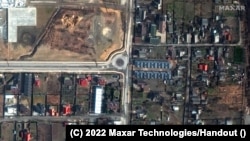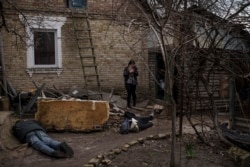On April 3, Ukrainian troops entered Bucha, a city northwest of Kyiv that the Russian military had occupied since Moscow launched a large-scale invasion of Ukraine on February 24.
When the Russians retreated, they left behind the bodies of scores of Bucha’s residents, some with signs of torture and execution-style murder. Dozens of bodies were in the streets, while hundreds of others were found in mass graves or in basements.
Ukrainian and Western journalists who entered Bucha with the Ukrainian military took photographs and videos of the dead bodies that elicited shock, international outrage and allegations, including from U.S. President Joe Biden, that the Russian forces had committed war crimes.
Russia said it was all phony.
“From what we have seen, those videos cannot be trusted, because there are signs of video forgeries and various kinds of fakes revealed by the specialists of the Ministry of Defense,” said Dmitry Peskov, spokesman for Russian President Vladimir Putin. “The factual, calendar sequence of events, also does not speak in favor of the reliability of these statements.”
Russian Foreign Minister Sergei Lavrov said: “The other day, another fake attack was launched in the city of Bucha, Kyiv region, after Russian servicemen left there in accordance with plans ... A dramatization was staged there a few days later, which is scattered on all the channels and social networks by Ukrainian representatives and their Western patrons.”
The Russian Defense Ministry denied that Russian troops attacked civilians in Bucha.
“All the photographs and video materials published by the Kyiv regime, allegedly testifying to some ‘crimes’ by Russian military personnel in the city of Bucha, Kyiv region, are another provocation,” the ministry said in a statement. “Of particular concern is the fact that all the bodies of people whose images are published by the Kyiv regime, after at least four days have not stiffened, do not have characteristic cadaveric spots, and there is uncoagulated blood in the wounds.”
The Russian Defense Ministry statement concluded: “All this irrefutably confirms that the photos and video footage from Bucha are yet another staged event by the Kyiv regime for the Western media, as it was in Mariupol with the maternity hospital, as well as in other cities.”
All these Russian claims are false.
Local authorities, residents and journalists who visited Bucha all testified to the authenticity of the photographs and videos. Reporters representing independent media from around the world interviewed locals, whose loved ones were killed by the Russian troops. They visited mass graves and basements to take videos and photos of the dead bodies.
After reviewing the videos and images, The New York Times concluded that “many of the civilians were killed more than three weeks ago, when Russia’s military was in control of the town, and have been rotting in the street ever since.”
“One video filmed by a local council member on April 2 shows multiple bodies scattered along Yablonska Street in Bucha. Satellite images provided to The Times by Maxar Technologies show that at least 11 of those had been on the street since March 11, when Russia, by its own account, occupied the town,” the newspaper reported.
Outraged by the Russian denials, some journalists shared via social media gruesome details of what they witnessed and experienced.
“I note that Russia now suggesting Ukrainians did Bucha executions themselves after Russian retreat. There is one reason why this can’t be true,” wrote Oliver Carroll, a reporter with the British magazine The Economist.
“The smell of the decomposing bodies. You simply don’t get such a strong odor after few days in very cold (near subzero) temperatures,” Carroll tweeted.
Human Rights Watch (HRW) said in an April 3 report that it had “documented cases of Russian military forces committing laws-of-war violations against civilians in occupied areas of the Chernihiv, Kharkiv, and Kyiv regions of Ukraine.”
“The cases we documented amount to unspeakable, deliberate cruelty and violence against Ukrainian civilians,” said Hugh Williamson, the group’s Europe and Central Asia director. “Rape, murder, and other violent acts against people in the Russian forces’ custody should be investigated as war crimes.”
“On March 4, Russian forces in Bucha, about 30 kilometers northwest of Kyiv, rounded up five men and summarily executed one of them,” HRW reported. “A witness told Human Rights Watch that soldiers forced the five men to kneel on the side of the road, pulled their T-shirts over their heads, and shot one of the men in the back of the head. ‘He fell [over],' the witness said, 'and the women [present at the scene] screamed’.”
Open source intelligence investigators also vetted photos and videos from Bucha. They confirmed that videos showing the executions of civilians were taken on March 25, when the city was still occupied by the Russians.
Another video published on Twitter on March 29 -- again, while Bucha was still under the Russian occupation -- shows bodies in black plastic bags being buried in a mass grave. The tweet says the bodies were among those of at least 67 civilians from Bucha killed by Russian forces.
Ukrainian officials said that the bodies of at least 410 civilians were found in the towns surrounding Kyiv after Russian troops pulled out of them.
"These are war crimes and will be recognized by the world as genocide," Ukraine’s President Volodymyr Zelenskyy said in a televised address to the nation from Bucha on April 4.
The United Nations called for an independent investigation of what happened in Bucha that would lead to “effective accountability.”
“Reports emerging from this and other areas, raise serious and disturbing questions about possible war crimes, grave breaches of international humanitarian law and serious violations of international human rights law,” U.N. human rights chief Michelle Bachelet said on April 4.






